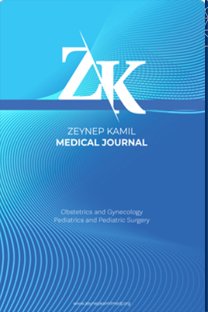Seroprevalence of Varicella-Zoster in the first trimester of pregnancy
Seroprevalence of Varicella-Zoster in the first trimester of pregnancy
___
- 1. Marino T, Smith SE, Laartz B. Viral infections and pregnancy. Medscape 2017. Update: Balducci J, Rodis JF, Rosengren S, Vintzileos AM, Spivey G, Vosseller C. Pregnancy outcome following first-trimester varicella infection. Obstet Gynecol 1992;79:5-6.
- 2. Tan M, Koren G. Chickenpox in pregnancy: Revisited. Reprod Toxicol 2005;21(4):410–20.
- 3. Sermet S. Fetal enfeksiyonlarin prenatal tanisi. Türk Klin J Gynecol Obst 2022;12(5):419–30.
- 4. Sauerbrei A, Wutzler P. Herpes simplex and varicella-zoster virus infections during pregnancy: Current concepts of prevention, diagnosis, and therapy. Part 2. Varicella-Zoster virus infections. Med Microbiol Immunol 2007;196:95–102.
- 5. Daley AJ, Thorpe S, Garland MS. Varicella and the pregnant women: Prevention and management. ANZJOG 2008;48:26–33.
- 6. Kirkham C, Harris S, Grzybowski S. Evidence-based prenatal care: Part II. Third-trimester care and prevention of infectious diseases. Am Fam Physician 2005;71(8):1555–60.
- 7. Demirören T, Yüksel A. Gebelikte infeksiyonlar (Toksoplazmozis, Rubella, sitomegalovirus, herpes simpleks, viral hepatitler, varisella, AIDS). T Klin J Gynecol Obst 2001;11:42–56.
- 8. Birch CJ, Druce JD, Catton MC, MacGregor L, Read T. Detection of varicella-zoster virus in genital specimens using a multiplex polymerase chain reaction. Sex Transm Infect 2003;79:298–300.
- 9. Paryani SG, Arvin AM. Intrauterine infection with varicella-zoster virus after maternal varicella. N Engl J Med 1986;314:1542–6.
- 10. Bialas KM, Swamy GK, Permar SR. Perinatal cytomegalovirus and varicella-zoster virus infections. Clin Perinatol 2014;42(1):61–75..
- 11. Pastuszak AL, Levy M, Schick B, Zuber C, Feldkamp M, Gladstone J, et al. Outcome after maternal varicella infection in the first 20 weeks of pregnancy. N Engl J Med 1994;344:350–1.
- 12. Sauerbrei A, Wutzler P. The congenital varicella syndrome. J Perinatol 2000;20:548–54.
- 13. Harger JH, Ernest JM. Thurnau GR, Moawad A, Momirova V, Landon MB, et al. Risk Factors and outcome of varicella-zoster virus pneumonia in pregnant women. J Infect Dis 2002;185:422–7.
- 14. Van Der Zwet WC, Vandenbroucke-Grauls CM, van Elburg RM, Cranendonk A, Zaaijer HL. Neonatal antibody titers against the varicella-zoster virus in relation to gestational age, birth weight, and maternal titer. Pediatrics 2002;109:79–85.
- 15. Saadatian-Elahi M, Mekki Y, Del Signore C, Lina B, Derrough T, Caulin E, et al. Seroprevalence of varicella antibodies among pregnant women in Lyon-France. Eur J Epidemiol 2007;22(6):405–9.
- 16. Socan M, Berginc N, Lajovic J. Varicella susceptibility and transmission dynamics in Slovenia. BMC Public Health 2010;10:360.
- 17. Sauerbrei A, Prager J, Bischoff A, Wutzler P. Antibodies against vaccine-preventable diseases in pregnant women and their offspring Measles, mumps, rubella, poliomyelitis, and varicella. Bundesgesundheitsblatt Gesundheitsforschung Gesundheitsschutz 2004;47(1):10–5.
- 18. Plans P, Costa J, Espunes J, Plasència A, Salleras L. Prevalence of varicella-zoster antibodies in pregnant women in Catalonia (Spain) rationale for varicella vaccination of women of childbearing age. BJOG 2007;114(9):1122–7.
- 19. Alanen A, Kahala K, Vahlberg T, Koskela P, Vainionpää R. Seroprevalence, incidence of prenatal infections and reliability of maternal history of varicella-zoster virus, cytomegalovirus, herpes simplex virus and parvovirus B19 infection in South-Western Finland. BJOG 2005;112(1):50– 6.
- 20. Talukder YS, Kafatos G, Pinot de Moira A, Aquilina J, Parker SP, Crowcroft NS, et al. The seroepidemiology of varicella-zoster virus among pregnant Bangladeshi and white British women in the London Borough of Tower Hamlets, UK. Epidemiol Infect 2007;135(8):1344–53.
- 21. Pandolfi E, Chiaradia G, Moncada M, Rava L, Tozzi AE. Prevention of congenital Rubella ned Congenital Varicella in Europa. Euro Surveill 2009;14(9):19133.
- 22. Knowles SJ, Grundy K, Cahill I, Cafferkey MT. Susceptibility to infectious rash illness in pregnant women from diverse geographical regions. Commun Dis Public Health 2004;7(4):344–8.
- 23. Dayan GH, Panero MS, Debbag R, Urquiza A, Molina M, Prieto S, et al. Varicella seroprevalence and molecular epidemiology of varicella-zoster virus in Argentina, 2002. J Clin Microbiol 2004;42(12):5698–704.
- 24. Guidoa M, Tinelli A, De Donno A, Quattrocchi M, Malvasi A, Campilongo F, et al. The seroepidemiology group susceptibility to varicella-zoster among pregnant women in the province of Lecce, Italy. J Clin Virol 2012;53:72–6.
- 25. Dilli D, Dallar Y, Önde U, Doğan F, Yağcı S. Ergenlerde kizamik, kizamikçik, kabakulak ve suçiçeği seroprevalansi. Çocuk Dergisi 2008;8(3):172–8.
- ISSN: 1300-7971
- Yayın Aralığı: Yılda 4 Sayı
- Yayıncı: Ali Cangül
Evaluation of blood pressures measured at the clinic and during exercise test in children
Nurdan EROL, Çiğdem EROL, İlke AKTAŞ
Ectopic pelvic kidney: Prenatal diagnosis and management
Gürcan TÜRKYILMAZ, Bilal ÇETİN
External anal sphincter repair by the overlapping method in obstetric anal sphincter injury syndrome
Filiz AKYÜZ, Sami AÇAR, Erman ÇİFTÇİ
Fırat TÜLEK, Bülent Berker, Alper KAHRAMAN
Anxiety, quality of life, eating behaviors, and sexual life in women with polycystic ovary syndrome
Gülfem BAŞOL, Sevil KİREMİTLİ, Tunay KİREMİTLİ, Paşa ULUĞ, Kemine UZEL
Funda GÜNGÖR UĞURLUCAN, Cenk YAŞA, Sina ARMAN, Ekin İlke ŞEN, Nalan ÇAPAN, Gülşah GULA, Ayşe KARAN
Seroprevalence of Varicella-Zoster in the first trimester of pregnancy
Effects of topical Povidone-iodine on thyroid function in surgical newborns
Ayşenur CELAYİR, Sırma Mine TİLEV, Burcu ARI, Tuba ERDEM
